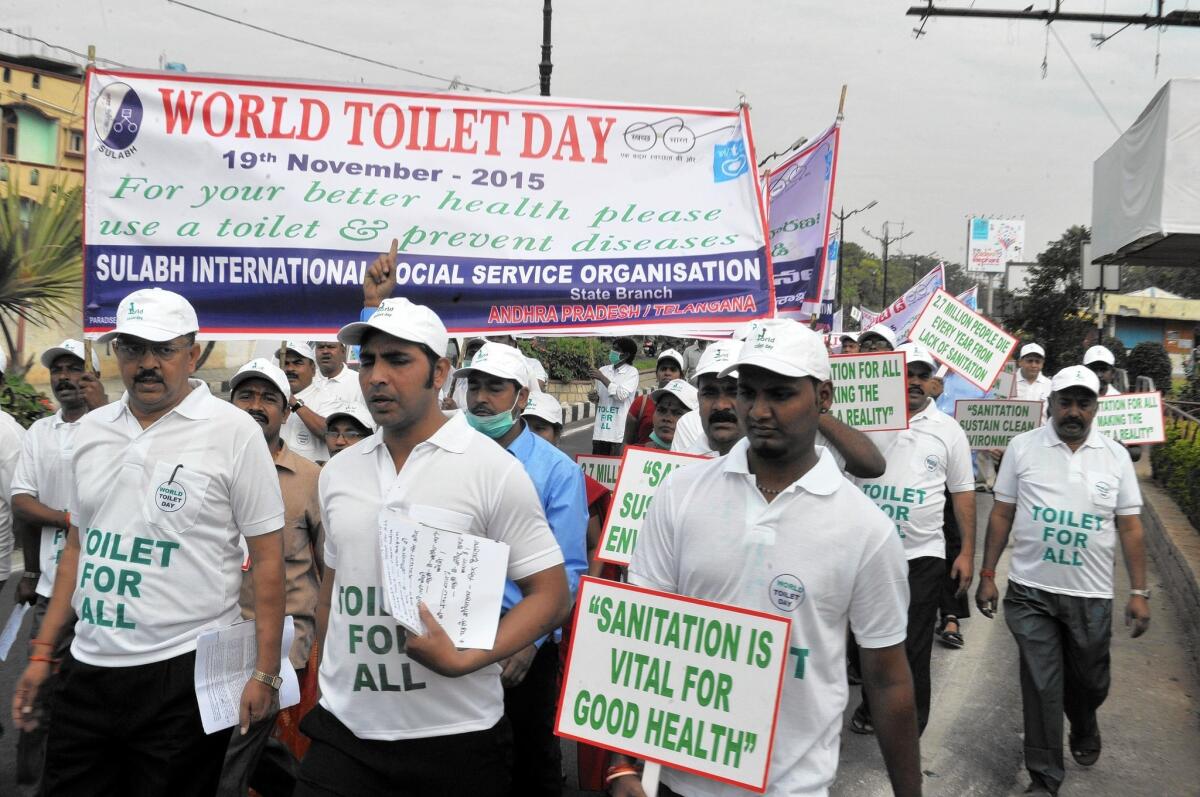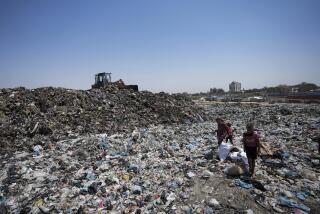A cry for help in India’s Bihar state: ‘We need a toilet desperately’

reporting from JAMSAUT, India — Kaliya Devi awakens at 4 a.m., fills a small bucket with water and walks 10 minutes to farmland outside her village in northern India. In the serene light of dawn, she finds a quiet, secluded spot to relieve herself.
While she and her five children do without a basic human convenience, a 10-foot-high pile of unused toilets sits in an angular brick structure across from her one-room home.
The ceramic bowls and tanks were dropped off three years ago by a charitable organization, Nari Gunjan, but were never installed.
Join the conversation on Facebook >>
“We were told we would be getting toilets very soon,” said Devi. “Nothing has happened since then.”
Sudha Varghese, the head of Nari Gunjan, said the government approved the toilet project but never provided money it promised for installation. Instead, middlemen with government contacts demanded commission to serve as intermediaries.
“We are not going to cooperate with the middlemen,” said Varghese. “The administrators should directly deal with the villagers.”
It is not the first time that hopes for improved sanitation in Jamsaut, in the impoverished northern state of Bihar, have failed to materialize.
In 2011, Bill and Melinda Gates visited the village to discuss their charitable foundation’s efforts to reduce infant and maternal mortality and stem diseases such as tuberculosis and diarrhea — problems that can be tackled with better sanitation facilities.
The Microsoft founder and his wife mingled with the residents of this village, who are Mahadalits, the lowest members of India’s hierarchical caste system, with the help of an interpreter. Devi does not know their names, but remembers meeting “an influential white couple” and looking at them with hope.
Four years later, the village of about 500 residents still has no toilets.
NEWSLETTER: Get the day’s top headlines from Times Editor Davan Maharaj >>
The Gates Foundation did not make specific commitments to Jamsaut, but the organization said it has helped the state of Bihar improve healthcare, including raising the rates of child immunization and the number of babies born in hospitals.
“Despite this progress, there is a lot of work still to be done,” Amy Enright, a spokeswoman for the foundation, wrote in an email. “This work is immense and beyond the scope of any one organization.”
Women say they are most affected by the lack of toilets.
“We have to go before the road gets busy, otherwise people see us,” Devi said as she skinned a chicken outside her home. Going to the bathroom outdoors also puts people at risk of snake bites, her friends added.
The United Nations reports that 665 million Indians — about half the nation’s population — lack access to toilets. The percentage is even higher here in Bihar, one of India’s poorest states, where one-third of people live on less than $1 a day.
Official statistics show that one-quarter of the state’s 21 million households have access to latrines. Only 58% of schools have dedicated toilets for girls.
“When someone has to relieve themselves in the dark, we go with a group,” said Devi, who is in her 40s. “We need a toilet desperately. We are tired of the charade every day. Plus, we are cursed at if someone sees us.”
Experts believe that many of the toilets that have been installed in Bihar are not functioning because of the lack of drainage and poor maintenance.
Even in the state capital, Patna, which glitters with shopping complexes and multiplexes, some residents say their toilets are clogged, leading to sewage overflows and a terrible stench.
Open defecation has been linked to assaults on women as well as diseases and stunted growth in children. In 2006, the economic cost of poor sanitation in India was estimated at $53.8 billion, or 6.4% of India’s gross national product. Countries with lower rates of open defecation than India include Angola, Burundi, Ethiopia, Ghana and Rwanda.
Indian Prime Minister Narendra Modi has promised to build more than 100 million toilets as part of a broad “Clean India” initiative. In a speech 13 months ago, he said protecting the “dignity of women” required modern sanitation facilities.
By August, the government said it had built 8 million toilets, but reports indicate that many are not functioning properly because of the lack of waste disposal systems, or because residents have not been educated on how to use them.
In parts of rural India, including Bihar, traditional beliefs suggest that accumulating feces near one’s home is inappropriate. The state government has begun a program to educate residents on the benefits of using toilets.
Bhaguni Manjhi, dressed neatly in jeans and a shirt, shows a badly constructed common toilet in Jamsaut, which cannot be used because it has not been connected to a drainage system.
“A young man like me can manage,” he said of the lack of working toilets. “But what about the old and infirm? They have to endure an ordeal every day.”
Parth M.N. is a special correspondent.
ALSO
A mayor in Mexico is shot dead a day after taking office
6.7 earthquake jolts northeastern India and Bangladesh, killing 13
Saudi Arabia cuts ties with Iran in crisis over cleric’s execution; other nations follow suit
More to Read
Sign up for Essential California
The most important California stories and recommendations in your inbox every morning.
You may occasionally receive promotional content from the Los Angeles Times.










